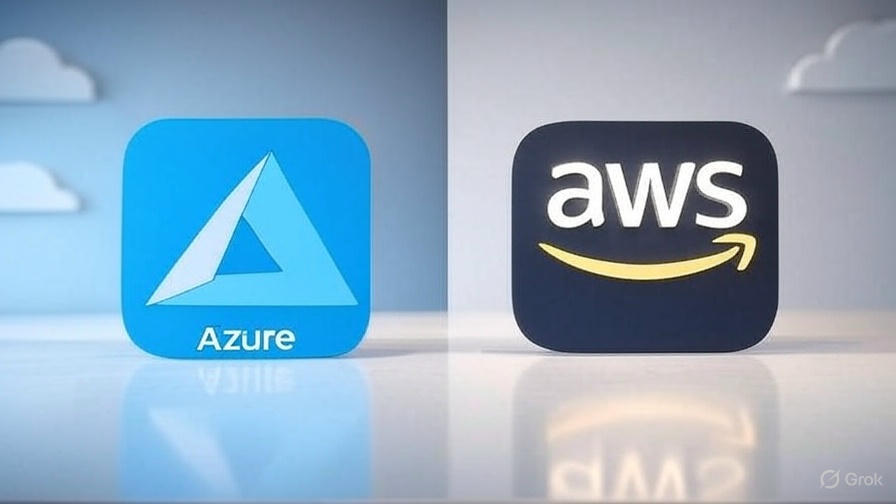In today’s cloud-first world, two platforms dominate the enterprise IT landscape—Amazon Web Services (AWS) and Microsoft Azure. Whether you’re an architect designing scalable cloud infrastructure, a DevOps engineer deploying microservices, or a CIO plotting a long-term cloud strategy, choosing the right provider can be a challenge.
Both AWS and Azure offer a vast range of services—from compute and storage to machine learning and IoT. But how do these cloud titans stack up against each other? This comparison will break down Azure vs AWS services across key areas to help you make informed decisions.
🌐 Overview: AWS vs Azure Market Position
Let’s start with the big picture.
- AWS launched in 2006 and remains the global leader in cloud computing. It holds approximately 31% of the cloud market share in 2025.
- Azure, which launched in 2010, has steadily grown and now holds around 25%, making it the second-largest cloud provider.
Both providers are widely adopted by Fortune 500 companies, government agencies, and startups alike. They’re trusted for their global infrastructure, robust security, and service breadth.
☁️ Compute Services: EC2 vs Azure Virtual Machines
AWS Compute – EC2
Amazon EC2 (Elastic Compute Cloud) is AWS’s flagship compute service, allowing users to spin up virtual machines (instances) with flexible OS and configuration choices. Features include:
- Auto-scaling
- Spot Instances for cost savings
- Graviton processors (ARM-based) for performance/cost balance
Azure Compute – Virtual Machines
Azure Virtual Machines offer similar capabilities, including support for Linux and Windows images, and integration with Azure services like Azure Monitor and Azure Resource Manager. Azure also has:
- Reserved VM Instances
- B-Series burstable VMs
- Hybrid benefit for Windows Server licenses
🟢 Winner: Tie — Both platforms offer powerful, scalable compute options. AWS has more instance variety, while Azure wins for hybrid licensing and Windows-centric enterprises.
💾 Storage Services: S3 vs Azure Blob Storage
AWS S3 (Simple Storage Service)
Amazon S3 is one of the most popular cloud storage services in the world. It supports:
- Object storage
- Lifecycle policies
- Versioning and intelligent tiering
- 99.999999999% durability (11 9s)
Azure Blob Storage
Azure Blob Storage offers similar capabilities, with tiers like Hot, Cool, and Archive for cost control. It integrates tightly with Azure Data Factory and Azure Synapse Analytics.
🟢 Winner: AWS – Slight edge due to more mature ecosystem and greater third-party integration.
🧠 AI & Machine Learning: SageMaker vs Azure Machine Learning
AWS AI/ML
Amazon SageMaker is a fully managed service for building, training, and deploying machine learning models. It supports Jupyter notebooks, automatic model tuning, and integration with TensorFlow, PyTorch, and Scikit-learn.
Azure AI/ML
Azure Machine Learning Studio offers a drag-and-drop UI for quick model development and is well-suited for users familiar with Microsoft tools. It supports AutoML and pipelines for MLOps integration.
🟢 Winner: Azure – Easier for newcomers and better integration with Power BI and other Microsoft tools.
🛡️ Security & Identity: IAM vs Azure Active Directory
AWS Security
AWS Identity and Access Management (IAM) allows detailed access policies and role-based permissions. AWS also offers tools like:
- AWS KMS (Key Management Service)
- GuardDuty
- AWS Shield for DDoS protection
Azure Security
Azure Active Directory (AAD) is a powerful identity service, especially for organizations already using Microsoft 365. Azure also includes:
- Azure Key Vault
- Microsoft Defender for Cloud
- Conditional Access policies
🟢 Winner: Azure – Best for enterprises standardized on Microsoft’s identity ecosystem.
🛠️ DevOps & CI/CD Tools
AWS DevOps Tools
- AWS CodePipeline
- CodeDeploy
- CloudFormation for infrastructure as code
Azure DevOps
- Azure DevOps Services (formerly VSTS) for end-to-end CI/CD
- Azure Resource Manager (ARM) templates
- Native GitHub integration (Microsoft-owned)
🟢 Winner: Azure – More mature and cohesive DevOps ecosystem, especially for teams already using GitHub or Visual Studio.
🌍 Global Reach & Availability Zones
- AWS has 99 Availability Zones across 31 regions.
- Azure has over 60 regions, more than any other provider.
While AWS generally has more redundancy options in some regions, Azure’s geographic reach is more extensive, especially in regions like Asia and Africa.
🟢 Winner: Azure – Greater global footprint.
💰 Pricing Comparison
Both AWS and Azure follow pay-as-you-go pricing models. However, pricing depends on usage, region, and service type. A few trends:
- AWS EC2 Spot Instances are often cheaper for compute.
- Azure Hybrid Benefit can significantly reduce costs for Windows-based workloads.
- Azure tends to be more cost-effective for long-term Microsoft-heavy infrastructures.
🟢 Winner: Tie — AWS is better for flexible pricing and short-term use, while Azure can offer better value for Microsoft-heavy environments.
🔄 Hybrid & Multi-Cloud Support
- Azure Arc: Enables hybrid deployments, multi-cloud governance, and Kubernetes management.
- AWS Outposts: Brings AWS hardware to on-premises environments but is more infrastructure-heavy.
🟢 Winner: Azure – More flexible and comprehensive hybrid cloud offerings.
🧩 Summary Table – AWS vs Azure Services
| Category | AWS Advantage | Azure Advantage |
|---|---|---|
| Compute | EC2 instance variety | Windows Server licensing |
| Storage | Mature S3 service | Native analytics integration |
| AI & Machine Learning | SageMaker capabilities | Power BI and AutoML integration |
| Security & Identity | IAM flexibility | Azure Active Directory |
| DevOps & CI/CD | CloudFormation, CodeDeploy | Azure DevOps, GitHub native |
| Global Reach | More AZs in some regions | More countries covered |
| Pricing | Spot Instances | Hybrid Benefit |
| Hybrid Cloud | AWS Outposts | Azure Arc |

🧩 AWS vs Azure Services Comparison Table
| Category | AWS Service | Azure Equivalent | Notes |
|---|---|---|---|
| Compute | EC2 (Elastic Compute Cloud) | Virtual Machines | Both offer broad OS support, auto-scaling, and reserved instance pricing |
| Lambda | Azure Functions | Serverless compute platform with event-driven execution | |
| ECS / EKS | Azure Kubernetes Service (AKS) | Managed container orchestration services | |
| Elastic Beanstalk | Azure App Service | PaaS for web apps and APIs | |
| Storage | S3 (Simple Storage Service) | Azure Blob Storage | Object storage with multiple tiers and lifecycle management |
| EBS (Elastic Block Store) | Azure Disk Storage | Persistent block storage for VMs | |
| Glacier | Azure Archive Storage | Cold storage/archive with low retrieval frequency | |
| Databases | RDS (Relational Database Service) | Azure SQL Database / Azure Database for MySQL | Managed relational databases with high availability |
| DynamoDB | Azure Cosmos DB | NoSQL, multi-model, global distribution | |
| Redshift | Azure Synapse Analytics | Data warehousing and big data analytics | |
| Networking | VPC (Virtual Private Cloud) | Virtual Network (VNet) | Isolated cloud networks with subnets, firewalls, etc. |
| Route 53 | Azure DNS | DNS hosting and routing | |
| CloudFront | Azure CDN | Global content delivery networks | |
| API Gateway | Azure API Management | API publishing, monitoring, and security | |
| Security & Identity | IAM (Identity and Access Mgmt) | Azure Active Directory (AAD) | User, role, and policy management |
| AWS KMS | Azure Key Vault | Encryption key management | |
| AWS Shield / WAF | Azure DDoS Protection / Azure Firewall | DDoS protection and application-layer firewalls | |
| AI/ML | SageMaker | Azure Machine Learning | ML model development and deployment |
| Rekognition | Azure Computer Vision / Face API | Image and facial recognition APIs | |
| Lex | Azure Bot Service | Conversational AI and chatbot development | |
| Monitoring & Tools | CloudWatch | Azure Monitor / Log Analytics | Performance monitoring, logging, and alerting |
| CloudTrail | Azure Activity Logs | Governance and audit trail tracking | |
| CloudFormation | ARM Templates / Bicep | Infrastructure as Code (IaC) | |
| AWS CodePipeline / CodeBuild | Azure DevOps / GitHub Actions | CI/CD pipelines and source control | |
| Hybrid Cloud | AWS Outposts | Azure Arc | Hybrid infrastructure management |
| Snowball | Azure Stack Edge | Data transfer and edge computing solutions |
🎯 Final Thoughts: Which One Should You Choose?
There’s no one-size-fits-all answer. The better choice depends on your organization’s needs:
- Choose AWS if you prioritize compute flexibility, third-party integrations, and have a team well-versed in AWS services.
- Choose Azure if you’re already embedded in the Microsoft ecosystem, require strong hybrid cloud support, or rely heavily on tools like Active Directory and Power BI.
For many enterprises, the answer may lie in multi-cloud adoption—leveraging the strengths of both platforms for different workloads.
For further reading, you can check out this Article from Google-Cloud-Post.
There is one article for – Scenario-Based Azure Functions Interview Questions (With Answers), you should read this for Azure related interview prep.
Happy coding dev, cheers 🙂

